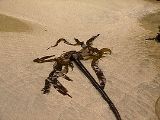
Nereocystis
Encyclopedia
Nereocystis is a genus of kelp
. It forms thick beds on rocks, and is an important part of kelp forests. There is only one species, Nereocystis luetkeana. It can grow to a maximum of 74 meters. Nereocystis has a holdfast
of about 40 centimeters, and a single stipe
, topped with a pneumatocyst
containing carbon monoxide
, from which sprout the numerous (about 30-64) blade
s. The blades may be up to 4 meters long, and up to 15 centimeters wide. It is usually annual, sometimes persisting up to 18 months. Nereocystis is the only kelp
which will drop spore patches, so that the right concentration of spores lands near the parent's holdfast
. It is common along the coast of the northeastern Pacific Ocean
, from about Monterey, California
to Aleutian Islands, Alaska
.
Some common names include edible kelp, bull kelp, bullwhip kelp, ribbon kelp, giant kelp, bladder wrack, and variations on these names.
Kelp
Kelps are large seaweeds belonging to the brown algae in the order Laminariales. There are about 30 different genera....
. It forms thick beds on rocks, and is an important part of kelp forests. There is only one species, Nereocystis luetkeana. It can grow to a maximum of 74 meters. Nereocystis has a holdfast
Holdfast
A holdfast is a root-like structure that anchors aquatic sessile organisms, such as seaweed, other sessile algae, stalked crinoids, benthic cnidarians, and sponges, to the substrate. ...
of about 40 centimeters, and a single stipe
Stipe (botany)
In botany, a stipe is a stalk that supports some other structure. The precise meaning is different depending on which taxonomic group is being described....
, topped with a pneumatocyst
Pneumatocyst
In phycology, a pneumatocyst is a large float containing gas found in brown algae. An organism may have more than one. They provide buoyancy to lift the blades toward the surface, allowing them to receive more sunlight for photosynthesis....
containing carbon monoxide
Carbon monoxide
Carbon monoxide , also called carbonous oxide, is a colorless, odorless, and tasteless gas that is slightly lighter than air. It is highly toxic to humans and animals in higher quantities, although it is also produced in normal animal metabolism in low quantities, and is thought to have some normal...
, from which sprout the numerous (about 30-64) blade
Blade
A blade is that portion of a tool, weapon, or machine with a cutting edge and/or a pointed tip that is designed to cut and/or puncture, stab, slash, chop, slice, thrust, or scrape animate or inanimate surfaces or materials...
s. The blades may be up to 4 meters long, and up to 15 centimeters wide. It is usually annual, sometimes persisting up to 18 months. Nereocystis is the only kelp
Kelp
Kelps are large seaweeds belonging to the brown algae in the order Laminariales. There are about 30 different genera....
which will drop spore patches, so that the right concentration of spores lands near the parent's holdfast
Holdfast
A holdfast is a root-like structure that anchors aquatic sessile organisms, such as seaweed, other sessile algae, stalked crinoids, benthic cnidarians, and sponges, to the substrate. ...
. It is common along the coast of the northeastern Pacific Ocean
Pacific Ocean
The Pacific Ocean is the largest of the Earth's oceanic divisions. It extends from the Arctic in the north to the Southern Ocean in the south, bounded by Asia and Australia in the west, and the Americas in the east.At 165.2 million square kilometres in area, this largest division of the World...
, from about Monterey, California
California
California is a state located on the West Coast of the United States. It is by far the most populous U.S. state, and the third-largest by land area...
to Aleutian Islands, Alaska
Alaska
Alaska is the largest state in the United States by area. It is situated in the northwest extremity of the North American continent, with Canada to the east, the Arctic Ocean to the north, and the Pacific Ocean to the west and south, with Russia further west across the Bering Strait...
.
Some common names include edible kelp, bull kelp, bullwhip kelp, ribbon kelp, giant kelp, bladder wrack, and variations on these names.

